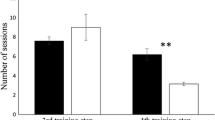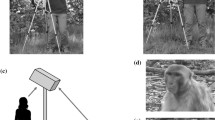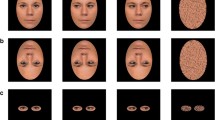Abstract.
The ability to discriminate between pairs of photographs according to the portrayed model's visual attention status was examined in four olive baboons. Two baboons successfully managed to solve the problem, even when attention was demonstrated by eye direction alone. A third showed an ability to discriminate head direction but not eye direction. In order to investigate further their ability to discriminate attention, the two successful baboons and two naïve baboons were presented with a simple object-choice task accompanied by experimenter-given cues. There was no evidence of transfer from the photographic stimuli to a real model; only one baboon showed signs of using the experimenter's attention to chose between two objects, and only after over 300 trials. These results could suggest that the baboons used simple physical cues rather than a concept of attention to solve the picture discrimination but alternative explanations are also discussed.
Similar content being viewed by others
Author information
Authors and Affiliations
Additional information
Accepted after revision: 5 February 2001
Electronic Publication
Rights and permissions
About this article
Cite this article
Vick, SJ., Bovet, D. & Anderson, J.R. Gaze discrimination learning in olive baboons (Papio anubis). Anim.Cogn. 4, 1–10 (2001). https://doi.org/10.1007/s100710100081
Received:
Issue Date:
DOI: https://doi.org/10.1007/s100710100081




